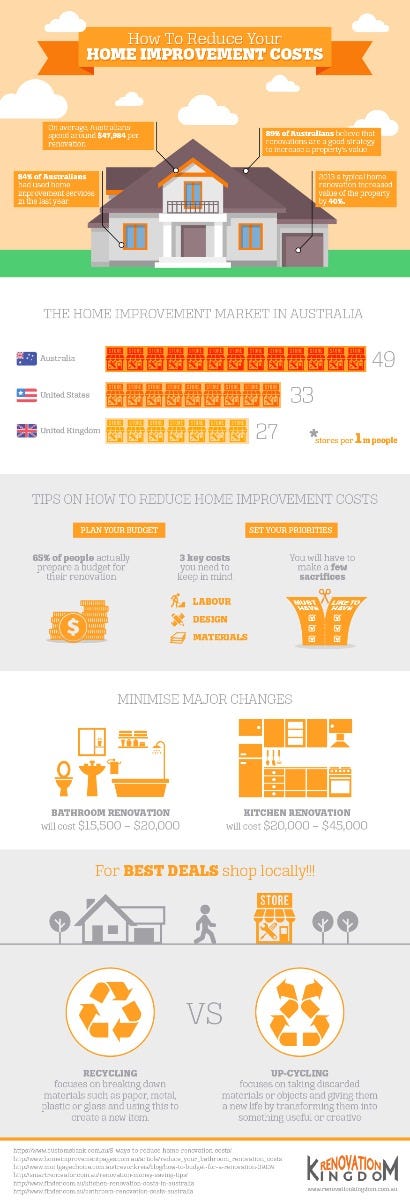HOW TO REDUCE YOUR HOME IMPROVEMENT COSTS

Home improvement is hugely popular in Australia, with as many as 89% of Australians believing that renovations are a good strategy to increase the value of their property.
Whether you’re looking to increase a property’s value, think your home is in need of a style upgrade or are simply looking to make your home more comfortable, there is no need for home improvements to cost you a fortune. We take a look at some simple ways you can reduce your home improvement costs.

The home improvement market
The home improvement market in Australia is huge, with Australians spending an average of $47,984 per renovation. It’s more popular than in many other countries, with Australia having 49 home improvement stores per 1m people, compared to 33 per 1m in the US and 27 per 1m in the UK.
The bad news is that according to recent surveys, the cost of renovating a home increased by 3.9% over the 2014-2015 financial year. Of course, Australians still believe that renovations are a good way to increase the value of their home. In fact, in 2013 a typical home renovation increased value of the property by 40%.
The recent increase in renovation costs appears to be directly correlated to the nation’s booming housing market. Renovations tend to increase during a property boom, with one 2014 study revealing that 84% of Australians had used home improvement services in the last year. In order to match demand, prices increase at a similar rate.
Tips on how to reduce home improvement costs
Of course, not everyone can afford to keep up with these price increases. Follow these helpful tips to help keep the costs down for your home renovation.
Plan your budget
Before you start any remodelling project, it is important that you do some research and plan your budget. A recent study found that only 65% of people actually prepare a budget for their renovation, but the last thing you want is to run out of funds halfway through a project.
There are three key costs you need to keep in mind; labour, design and materials. Choosing materials, appliances and fixtures before you begin a project will help you to stick to your budget. Make sure you shop around and compare prices, but don’t scrimp on quality.
Labour usually makes up about a third of the total expense. You can keep costs down by doing some of the work yourself. If you need a professional, make sure you choose reliable tradespeople. Ask friends, families and colleagues for referrals, compare quotes and make sure you check references.
Set your priorities
When you’re renovating on a budget, you are more than likely going to have to make a few sacrifices along the way. A good way to set your priorities is to make a list of the must-haves, and separate these from the things you would simply like to have. Anything you can’t afford will need to be removed from the list.
Minimise major changes
Two commonly renovated rooms are the kitchen and bathroom, but if you are not careful, you can add huge, unnecessary expenses to your renovation. Your average bathroom renovation will cost $15,500 – $20,000, going up to $20,000 – $45,000 for a standard kitchen renovation.
Major alterations, such as plumbing, electrical and structural changes tend to be very costly. Try to keep things simple and do it yourself where you can. Simple swaps such as opting for vinyl flooring instead of ceramic or porcelain tiles, and using an acrylic splashback instead of pricey wall tiles will help you to cut down on cost without missing out on the luxury factor.
Shop locally
When it comes to remodelling, try shopping locally for your materials wherever possible. Whether you need kitchen fixtures, paint or bathroom accessories local shops tend to have the best deals.
Recycle and Upcycle
Recycling and up-cycling furniture and fixtures can help to significantly lower home renovation costs.
- Recycling:This focuses on breaking down materials such as paper, metal, plastic or glass and using the resulting material to create a new item.
- Up-cycling:This is all about taking discarded materials or objects and giving them a new life by transforming them into something useful or creative.
Reclaimed wood is a popular ‘green’ building material and can be used in everything from floors to furniture and decking. It is considerably cheaper than buy than new wood and has its own distinctive look.
With a little creativity, you can bring down the costs of a home renovation while still adding value and style to your property.


